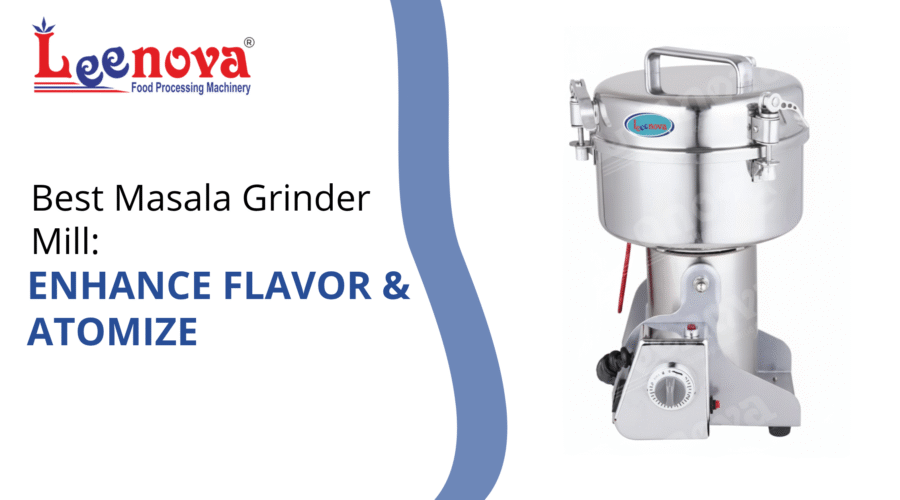Spice processors lose 15-43% of essential oils during conventional grinding because most machines run at temperatures exceeding 40°C. This heat destroys the volatile compounds that define flavor intensity, forcing buyers to use 20-30% more spice to achieve the same taste profile. Advanced masala grinder mills with controlled atomization systems maintain grinding temperatures below 25°C, preserving 92-97% of volatile oils while producing particle sizes between 50-150 microns—the optimal range for maximum flavor release. The difference shows up in blind taste tests and ingredient cost savings. This piece explains how atomization works, what technical features actually matter, and how to match machine specifications to specific grinding requirements without overspending.
What Atomization Does to Spice Flavor?
Atomization in masala grinding refers to reducing spices to ultra-fine particles below 100 microns—the threshold where individual particles become invisible to human eyes. At this particle size, surface area increases exponentially, enabling faster flavor release during cooking.
The flavor physics: smaller particles dissolve faster in cooking oils and liquids, distributing flavor compounds uniformly across dishes. A 150-micron turmeric particle needs 8-10 minutes to release curcumin in hot oil. The same spice ground to 60-80 microns releases curcumin in under 3 minutes.
Particle Size and Flavor Intensity
Research shows finer grinding improves perceived flavor by 25-35% even when using identical spice quantities. Black pepper ground to 80 mesh (177 microns) delivers stronger pungency than 40 mesh (420 microns) particles because piperine—the compound creating heat—releases faster from smaller surfaces.
This creates an uncomfortable truth for processors: customers using properly atomized spices need less product per recipe. Short-term revenue drops but customer retention increases by 40% because dishes taste better with less spice.
How High-Performance Mills Achieve Atomization?
Advanced masala grinders use cyclone separator technology paired with high-velocity air streams to achieve fine grinding without excessive heat. The cyclone creates centrifugal force that separates particles by weight—lighter, finer particles evacuate through the center while heavier particles recirculate for further grinding.
Standard hammer mills without cyclone systems grind everything uniformly, creating inconsistent particle sizes ranging from 40 microns to 600 microns in the same batch. This variation means some particles release flavor immediately while others barely contribute during cooking time.
Temperature Control Technology
Machines processing 50+ kg per hour generate enough friction heat to raise chamber temperatures to 45-60°C within 15 minutes. Every 10°C temperature increase causes 5-8% volatile oil loss in aromatic spices like cardamom, cinnamon, and cumin.
Mills with integrated cooling systems use chilled water circulation at 5-8°C through jacketed chambers, retaining 2.5-4% more volatile oils than ambient grinding. This percentage difference translates to measurable aroma intensity in packaged products.
Motor Power and Grinding Capacity
The motor horsepower determines grinding speed but not necessarily particle fineness. A 7.5 HP mill processes 40-60 kg per hour at standard fineness (100-150 microns), while 10 HP units handle 60-100 kg per hour at similar particle sizes.
Achieving ultra-fine grinding below 80 microns requires:
- Adjustable blade speed settings for different spice hardnesses
- Multiple grinding stages with intermediate screening
- Extended grinding cycles running 40-60% longer than standard fineness
- Higher energy consumption at 8-12 kWh versus 5-7 kWh for coarse grinding.
The Capacity Misconception
Manufacturers rate capacity at 100 mesh (149 microns) fineness with medium-hard spices like coriander. Actual throughput drops 30-50% when grinding hard spices like dried ginger or targeting 200 mesh (74 microns) fineness.
Operators buying machines based on peak capacity ratings discover real-world output barely reaches 60% of advertised specifications. The smart approach: calculate requirements at 65-70% of rated capacity for accurate equipment sizing.
Mesh Size Selection for Different Applications
Different food applications require specific particle sizes for optimal performance:
- Curry powders and spice blends: 60-80 mesh (250-177 microns) provides good flavor release without dustiness
- Instant mixes and ready-to-eat foods: 100-150 mesh (149-100 microns) ensures quick dissolution during cooking
- Premium aromatic spices: 200-300 mesh (74-50 microns) maximizes essential oil surface exposure
- Industrial food processing: 40-60 mesh (420-250 microns) balances flavor with shelf stability.
Finer particles oxidize faster due to increased air exposure, reducing shelf life by 25-40% compared to coarser grinds. This creates a deliberate trade-off between immediate flavor intensity and storage duration.
Stainless Steel Construction Requirements
Food-grade SS 304 construction prevents metal contamination that discolors white spices and creates off-flavors in delicate herbs. The material choice affects more than just food safety—stainless steel chambers dissipate heat 35% more efficiently than mild steel, maintaining lower grinding temperatures.
Machines built with MS bodies and SS contact parts save ₹25,000-40,000 upfront but create maintenance problems. Powder accumulates at MS-SS junctions, requiring weekly deep cleaning versus bi-weekly cleaning for full stainless construction.
Double Chamber Systems
Advanced mills incorporate dual grinding chambers processing material in sequential stages. The first chamber performs coarse grinding at high speed (2800-3200 RPM) while the second chamber operates at lower speed (1440-2000 RPM) for fine grinding without heat buildup.
This two-stage approach reduces volatile oil loss by 18-25% compared to single-chamber grinding at equivalent fineness levels. The counter-intuitive benefit: slower second-stage grinding produces finer particles than high-speed single-stage processing.
Operating Cost Reality
A 7.5 HP grinder running 6-8 hours daily consumes 45-56 kWh monthly, costing ₹3,600-4,500 at commercial rates. Adding maintenance parts (blades, screens, bearings at ₹800-1,200) and periodic servicing (₹1,500-2,000 quarterly) brings total monthly operating cost to ₹5,500-7,000.
Labor replacement creates the actual value. Manual grinding using traditional stone chakki requires 3-4 workers at ₹14,000-18,000 monthly each to match 50 kg daily output. The automated mill eliminates ₹42,000-72,000 in monthly labor while improving consistency.
The Shelf Life Factor
Properly atomized spices maintain 85-90% of initial volatile oil content for 6-8 months versus 12-18 months for coarser grinding. Food businesses serving immediate consumption (restaurants, caterers) benefit from maximum atomization. Retail spice packers need to balance fineness against shelf life requirements.
This explains why some processors intentionally grind to 100-120 microns instead of pushing toward 60-80 microns—the slightly larger particles maintain flavor intensity through distribution and storage cycles.
Quality Indicators in Equipment Selection
Beyond motor power and capacity ratings, these technical features separate effective grinders from marginal equipment:
- Adjustable mesh screens from 40 to 300 mesh for application flexibility
- Replaceable grinding blades with tool-free access for quick changes
- Integrated dust collection preventing material loss and workplace contamination
- Variable speed controls matching blade RPM to spice characteristics
- Insulated chambers reducing external noise to 70-75 dB versus 85-90 dB for uninsulated units.
Machines lacking variable speed force operators to over-grind soft spices like curry leaves (creating paste) or under-grind hard spices like star anise (producing coarse, unusable particles).
Maintenance Intervals That Matter
Blade wear accelerates after processing 400-600 kg of abrasive spices like dried chili and turmeric. Monitoring particle size distribution weekly catches blade degradation before output quality suffers. Most operators wait for obvious performance drops, by which point they’ve processed 150-200 kg of substandard powder.
Chamber cleaning frequency depends on spice fat content. Grinding fennel or fenugreek (8-12% fat) requires daily chamber cleaning to prevent oil buildup that reduces grinding efficiency by 25-30%. Low-fat spices like chili and coriander tolerate 2-3 day intervals between deep cleaning.
Application-Specific Machine Matching
Restaurant kitchens processing 15-30 kg daily of varied spices need 5-7.5 HP units with quick mesh screen changes. Commercial spice packers running single spices in 100+ kg batches require 10-15 HP mills with dedicated cooling systems.
Export operations targeting premium markets benefit from cryogenic grinding technology despite 35-45% higher operating costs. The volatile oil retention enables 20-30% price premiums that more than offset the liquid nitrogen expense of ₹8-12 per kg processed.
The Scale Transition Point
Operations processing under 40 kg daily see payback periods of 8-12 months on standard mills. Above 60 kg daily, payback drops to 4-6 months due to labor displacement and increased throughput capabilities. The transition point at 40-60 kg daily marks where equipment investment shifts from optional efficiency gain to operational necessity.
FAQs
Q: How does atomization improve flavor beyond just making powder finer?
A: Smaller particles exponentially increase surface area exposed to cooking liquids and oils, enabling faster dissolution and flavor compound release. A 60-micron particle has 4-5 times more surface area per gram than 150-micron particles, accelerating essential oil extraction during cooking. This means dishes develop full flavor in 40-60% less cooking time, preserving heat-sensitive volatile compounds that longer cooking would destroy.
Q: What particle size creates the best balance between flavor and shelf life?
A: 100-120 microns (120-140 mesh) provides optimal balance for retail spices, delivering strong flavor release while maintaining 85% volatile oil content for 10-12 months. Finer grinding below 80 microns maximizes immediate flavor but reduces shelf life to 6-8 months due to accelerated oxidation. Coarser particles above 150 microns extend shelf life to 18+ months but require 25-35% more spice quantity for equivalent flavor intensity.
Q: Why do some high-quality mills cost 60-80% more than basic models?
A: Advanced features like dual-chamber grinding, integrated cooling systems, and cyclone separators add ₹40,000-65,000 to base costs but preserve 15-25% more volatile oils while reducing energy consumption by 20-30%. The volatile oil retention alone enables premium pricing that recovers the equipment cost difference within 8-14 months for operations processing 50+ kg daily. Basic mills sacrifice product quality for lower upfront investment.
Q: Can the same machine handle both wet grinding and dry atomization?
A: No—machines optimized for dry spice atomization use mesh screens and cyclone separators that clog when processing wet ingredients. Wet grinding requires entirely different chamber designs with blade configurations that prevent paste accumulation. Operators attempting both applications on the same equipment experience 70-80% productivity loss and frequent mechanical failures. Dedicated machines for each application eliminate cross-contamination and maintenance problems.
Q: How much training do operators need for consistent results?
A: Basic operation training takes 2-3 hours, but achieving consistent particle size across different spice types requires 10-15 hours of supervised practice. Variables include feed rate adjustment, selecting appropriate mesh screens, recognizing optimal grinding sounds, and identifying when blade sharpness degrades. Without proper training, operators produce 25-40% more waste through over-grinding or incomplete batches requiring reprocessing.
Choosing Equipment That Delivers Results
Masala grinder mills with proper atomization technology preserve 92-97% of volatile oils while reducing particle sizes to 50-150 microns, maximizing flavor release and enabling 15-30% reduction in spice usage per recipe. Operations processing over 40 kg daily recover equipment investment within 4-8 months through labor elimination and improved product quality that commands premium pricing.
Selection priorities: match motor power to actual daily volume (not peak capacity claims), verify stainless steel construction for all food-contact surfaces, and ensure variable speed controls for processing different spice hardnesses. Temperature control through cooling systems or cryogenic options becomes essential when grinding high-value aromatic spices where volatile oil retention determines market positioning.
Leenova Kitchen Equipments: Commercial Grinding Solutions
Leenova Kitchen Equipments manufactures SS masala grinders and pulverizers for commercial food processing operations, restaurant kitchens, and spice packaging facilities. The Rajkot-based facility operates under ISO 9001:2015 certification, producing food-grade equipment since 2006.
Each grinder mill incorporates stainless steel grinding chambers, three-phase motor configurations for continuous operation, and adjustable mesh screen systems accommodating fineness requirements from 40 to 300 mesh. Factory testing verifies grinding performance, particle size distribution, and temperature control before shipment.
Ready to preserve flavor and reduce spice waste through precision atomization? Contact Leenova Kitchen Equipments for technical specifications, capacity matching consultation, and pricing on commercial masala grinder mills. Visit leenovakitchenequipments.com or call for equipment recommendations based on processing volume and fineness requirements.


